 |
 |
 |
| |
Aging and Antiretroviral
Neurotoxicity
|
| |
| |
Scott Letendre, M.D.
Professor of Medicine and Psychiatry
University of California, San Diego
Reported by Jules Levin
8th International Workshop on HIV and Aging, October 2-3, 2017, New York
Pdf attached
Aging and Antiretoviral Neurotoxicity.pdf

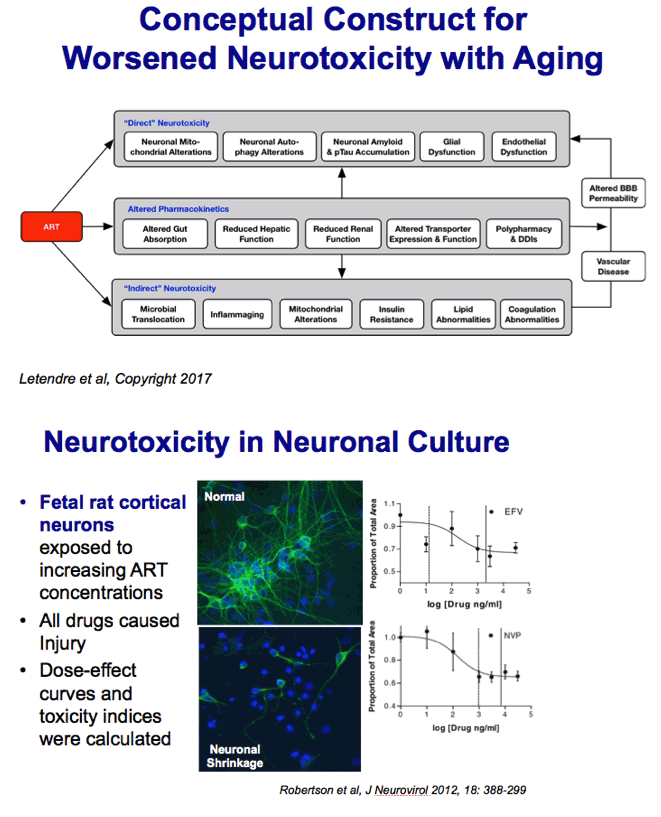
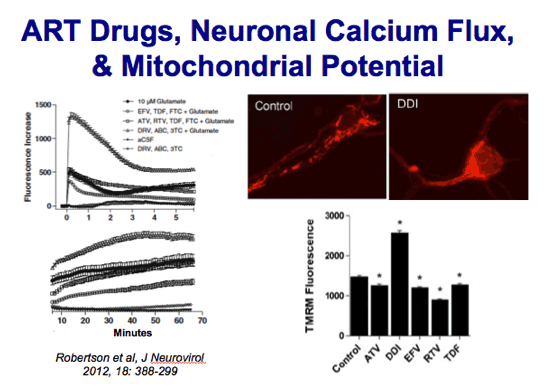
http://www.natap.org/2013/HIV/art3A10.10072Fs13365-012-0120-3.pdf
http://www.natap.org/2010/CROI/croi_56.htm
http://natap.org/2014/HIV/012315_03.htm
http://www.natap.org/2016/CROI/croi_231.htm
Neuronal calcium responses to a 10 μM glutamate challenge after incubation in the indicated antiretroviral cocktail for 2 days. The mean fluorescence of neurons loaded with the calcium indicator dye Fluo-4 was measured over time. Fluo-4 fluorescence is proportional to the intracellular calcium concentration. A robust acute response to glutamate was seen in the control neurons (filled circles) receiving no antiretroviral treatment followed by a slight rise in the delayed phase.
Pre-treatment of the neurons with the ARV combination ATV, RTV, TDF, FTC (open squares) resulted in a similar acute and delayed response. Pre-treatment with the more toxic combination of DRV, ABC, 3TC (open triangles) resulted in a much greater acute response followed by a larger delayed accumulation of calcium. The less toxic combination of EFV, TDF, FTC (open circles) reduced the magnitude of the acute response to glutamate. Although the net accumulation of calcium was lower, the rate of accumulation in the delayed phase was similar to the other ARV combinations. Neurons directly challenged with the ARV cocktail (DRV, ABC, 3TC; open diamonds) in the absence of glutamate had no effect on intracellular calcium and were indistinguishable from aCSF controls
Examples of cultured neurons stained with the mitochondrial potential sensitive dye TMRM. Control mitochondria were seen as
brightly stained, long fingerlike structures in the neurons. Treatment with RTV depleted the mitochondrial membrane potential as indicated by the low intensity of the TMRM stain. EFV had a small effect on the intensity of TMRM. DDI induced an increase in the TMRM fluorescence indicating an increase in the mitochondrial membrane potential. Each compound tested caused a slight rounding of the mitochondria. b Quantification of the average TMRM fluorescence in neurons treated with different ARVs. All ARVs tested resulted in a significant decrease in the TMRM fluorescence with the exception of DDI which increased the fluorescence (*p<0.05). c A frequency analysis illustrating the shift in the distribution of TMRM intensities for each ARV. Most ARVs induced a small shift to the left (decrease in mitochondrial membrane potential). RTV induced the largest shift to the left, whereas DDI produced a notable shift to the right
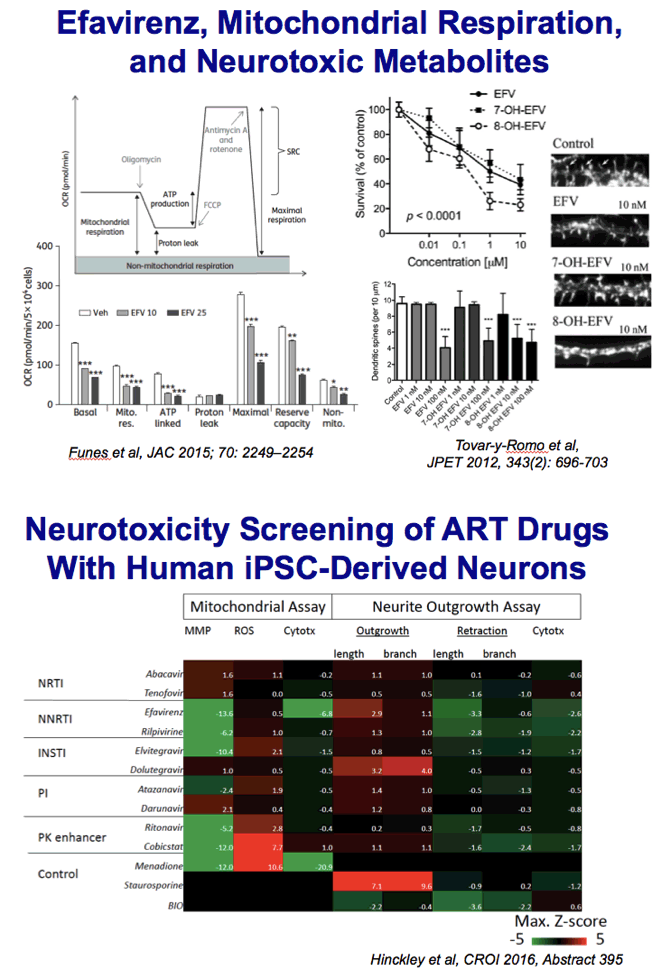
CROI: Neurotoxicity Screening of Antiretroviral Drugs With Human iPSC-Derived Neurons
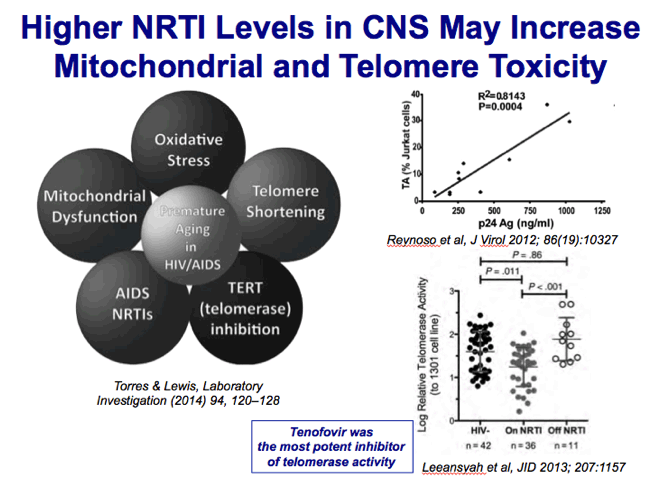
structural similarity between nucleoside analogs and native nucleosides/nucleotides enables NRTIs to interfere with
HIV-1 reverse transcriptase (RT) and inhibit viral replication.41 Eukaryotic nuclear DNA polymerases that replicate and repair nuclear DNA are less significantly inhibited by NRTI triphosphates than is HIV-1 RT. Among the eukaryotic polymerases, pol g, the eukaryotic mtDNA replicase is inhibited by NRTI triphosphates at micromolar levels, which is toxicologically relevant
The 'pol g hypothesis' does not completely explain all toxic manifestations of NRTIs; the exceptions that exist invoke other toxic mechanisms; however, the structure-function relationship for some thymidine analogs as mitochondrial toxins is reasonably established and has held true in clinical trial where mitochondrial toxicity caused cessation long-term toxic effects (as may be seen in aging patients treated for decades) are less well studied. These toxic events may relate mechanistically to myocardial infarct, congestive heart failure, liver failure, renal failure, peripheral neuropathy, lactic acidosis, and muscle toxicity in HIV/AIDS mtDNA depletion leads to reduction of mitochondrially encoded proteins that have important roles in the ETC for OXPHOS. OXPHOS dysfunction promotes electron leak (uncoupling) and superoxide production as well. Such defects in mtDNA replication and decreased energetics are caused by AZT in vivo using various animal models including rats and TG mice harboring genes of HIV, and that are treated with mono-NRTI and HAART combinations 8-Hydroxydeoxyguanosine (8-OHdG) is an oxidative base product of DNA that reflects oxidative stress and clinical mitochondrial dysfunction; 8-OHdG is present in mtDNA at levels 16-fold higher of those in nuclear DNA.68,69 8-OHdG in DNA leads to GC-TA transversions unless the error is repaired.70
Therefore, 8-OHdG is a potent mutagen that could relate to NRTI toxicity.71 This is clinically important because trace amounts of 8-OHdG in the mitochondria can markedly reduce DNA pol g replication fidelity, as suggested by the data from studies in vitro. Telomeres cap the ends of chromosomes and consist of hexameric TTAGGG repeats and the protective 'sheltering' protein complex.108,109 Telomerase is a ribonucleoprotein consisting of a reverse transcriptase (TERT) and its RNA moiety (TERC). An 'end replication problem' causes telomeres to shorten during each replication cycle to yield persistent DNA damage and growth arrest (senescence) and limited regenerative capacity of tissues. Its expression causes cellular immortality. Although shortening and/or damage to telomeres is associated with proliferative arrest of cells in vitro, it remains unclear how accurately these diseases recapitulate the processes of tissue aging in humans. Telomerases, including TERT, possess the ability to perform 'repeat addition processivity.' As such, TERT repetitively reverse transcribes a relatively short RNA template. For processive DNA synthesis to occur, the 30 end of the ssDNA substrate must pair with the telomerase RNA template that creates a DNA-RNA heterodimer. This is reverse transcribed for synthesis of one of the telomeric repeats. DNA synthesis on the same substrate is followed by realignment of the template and repetition of the process. NRTIs are known inhibitors of HIV-1 RT, and NRTIs inhibit eukaryotic pol g (the mtDNA replicase that also has RT activity).120,121 Early
in the HIV/AIDS epidemic, it was discovered that the effect of NRTIs, including AZT, caused progressive telomere shortening in immortalized B- and T-cell lines.122 More recently, an inhibitory effect of NRTI phosphates on human peripheral blood mononuclear cell TERT indicated that many phosphorylated NRTIs (including lamivudine, abacavir, zidovudine, emitricitabine and particularly the nucleotide analog tenofovir) were inhibitors of TERT

FROM JULES: I THINK when he was talking Letendre said the regimen above was stated wrong, it is not TDF+ATV?SQV but another regimen.
Antiretroviral drugs induce neuronal damage in vivo. a-d Formalin-fixed, paraffin-embedded tissue sections from hippocampus of pigtailed macaques that were either uninfected (n=6), SIV infected but not cART treated (n=7), or SIV infected and treated with cART (tenofovir, atazanavir, saquinavir, and L-870812a; n=4) were prepared for immunofluorescent analysis and were triple labeled for MAP2 (red), synaptophysin (green), and GFAP. Representative composite images of two cases per group which were stained with MAP2 and synaptophysin are shown
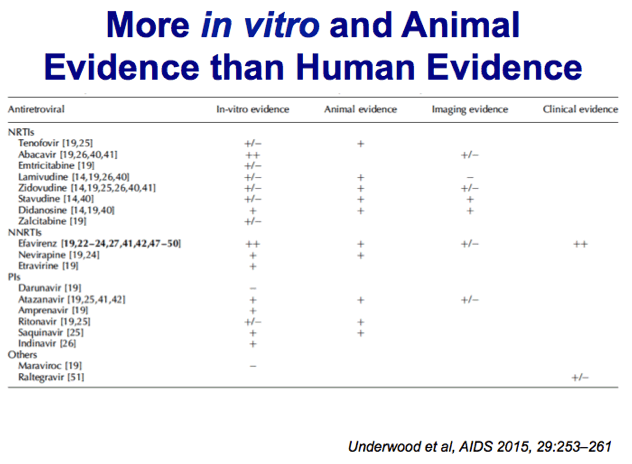
Key: S, significant toxicity unlikely at clinical doses/no evidence of toxicity; R/S, possible evidence of toxicity but probably not significant at clinical doses or conflicting reports; ?, some evidence of toxicity at clinical doses; ??, toxicity likely at clinical doses/reasonable evidence of toxicity. NNRTI, non-nucleoside reverse transcriptase inhibitor; NRTI, nucleoside reverse transcriptase inhibitor; PI, protease inhibitor.

this study did not include integrate inhibitors, did include all old PIs and nukes - and bear in mind atazanavir has been found to be cardio protective due to elevated billirubin.

According to the National Cholesterol Education Program (NCEP) Adult Treatment Panel (ATP) III guidelines (2005), metabolic syndrome was defined as having three or more of the following criteria: (i) waist measurement ≥80 cm for women and ≥90 cm for men; (ii) TG level of ≥150 mg/dL or drug treatment for elevated TG level; (iii) HDL-C of < 50 mg/dL for women and < 40 mg/dL for men or drug treatment for reduced HDL-C; (iv) elevated blood pressure (systolic ≥130 mmHg or diastolic ≥85 mmHg, using the average of two seated measurements) or antihypertensive drug treatment; and (v) fasting glucose ≥100 mg/dL or currently using anti-diabetic medications.
Objectives: Metabolic complications related to antiretroviral therapy are rarely investigated among HIV-infected patients in Asian countries. We investigated the prevalence of and factors associated with metabolic
syndrome among HIV-infected patients who are ethnic Chinese in the era of highly active antiretroviral therapy (HAART).
Methods: A cross-sectional survey was performed to collect information on the demographic and clinical characteristics and antiretroviral therapy prescribed in 877 HIV-infected patients at a university hospital in Taiwan
from May 2008 to April 2009. The modified Adult Treatment Panel III criteria were used to define metabolic syndrome after adjusting for the waist circumference criteria for Asians.
Results: Of the 877 patients, 75.3% were male homosexuals, 80.7% were receiving HAART and 88.7% had CD4 counts ≥200 cells/mm3. Metabolic syndrome was diagnosed in 210 patients (26.2%). After adjusting for age,
gender, smoking status, family history of diabetes mellitus, cardiovascular disease and hypertension, and baseline CD4 and plasma HIV RNA load, use of protease inhibitors (PIs) was significantly associated with the presence of metabolic syndrome (OR 1.63; 95% CI 1.10-2.43). In addition, exposure to PI for ≥3 years, to HAART for ≥6 years and to nucleoside reverse transcriptase inhibitor(s) for ≥6 years was significantly associated with the presence of metabolic syndrome with an adjusted OR of 1.96 (95% CI 1.13-3.42), 1.78 (95% CI 1.03-3.07), and 1.91 (95% CI 1.11-3.30), respectively.
Conclusions: Approximately one-fourth of HIV-infected Taiwanese patients developed metabolic syndrome in the HAART era. Receipt of HAART and prolonged exposure to PI and nucleoside reverse transcriptase inhibitor(s) were associated with metabolic syndrome.
Pdf attached
Download the PDF here


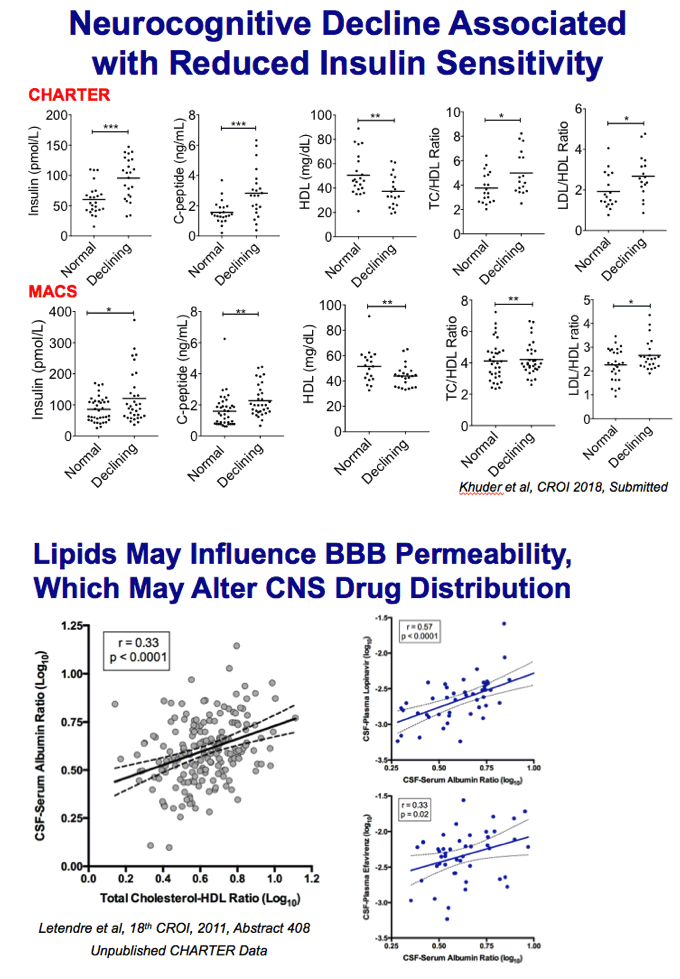

from Jules: in his talk Letendre did refer to the data from Esteban Martinez which was reported at the 2017 Adverse Events Workshop in
Sept NYC, and Letendre made reference to this - that age apparently was the only statistically significant risk factor for early discontinuation
due to AEs:
Tolerability of integrase inhibitors in a real-life setting - Barcelona - (09/22/16)
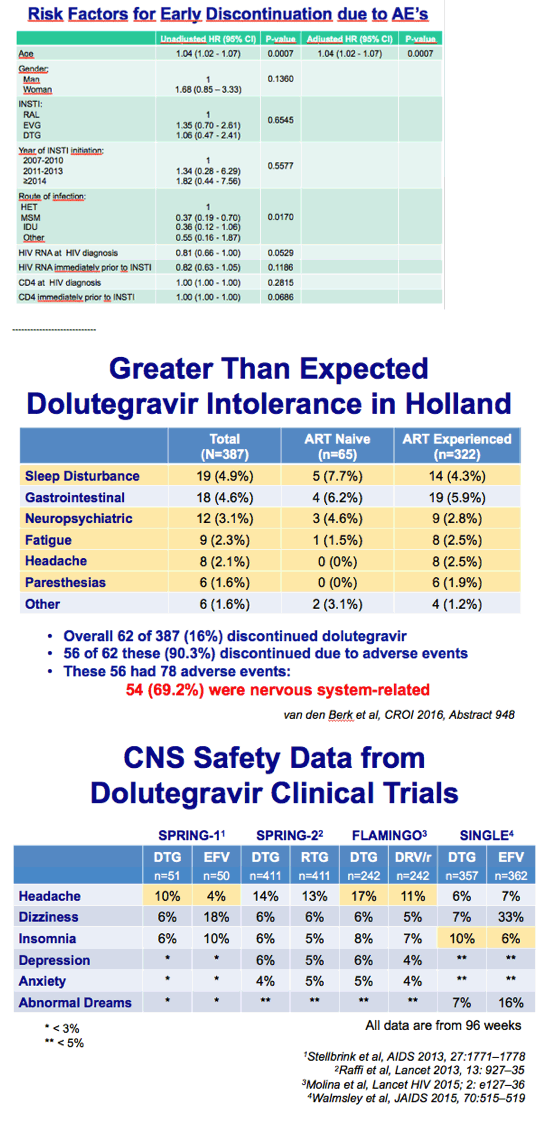

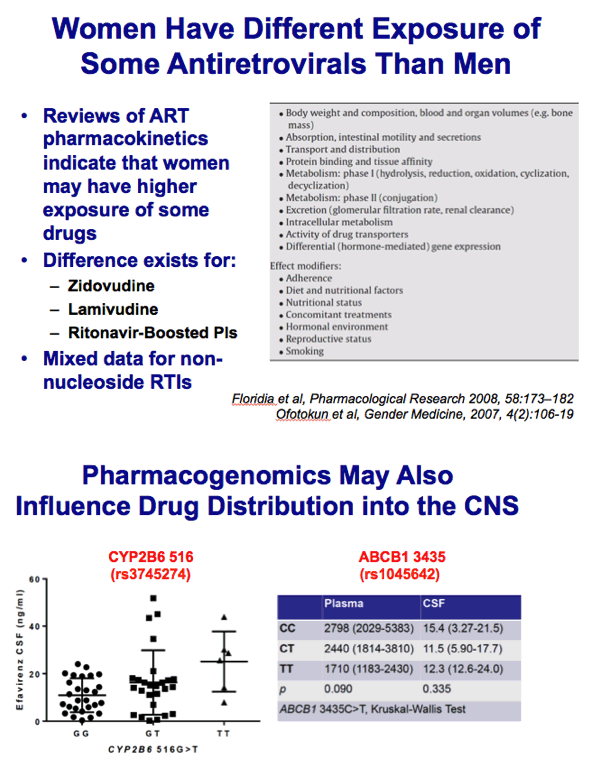
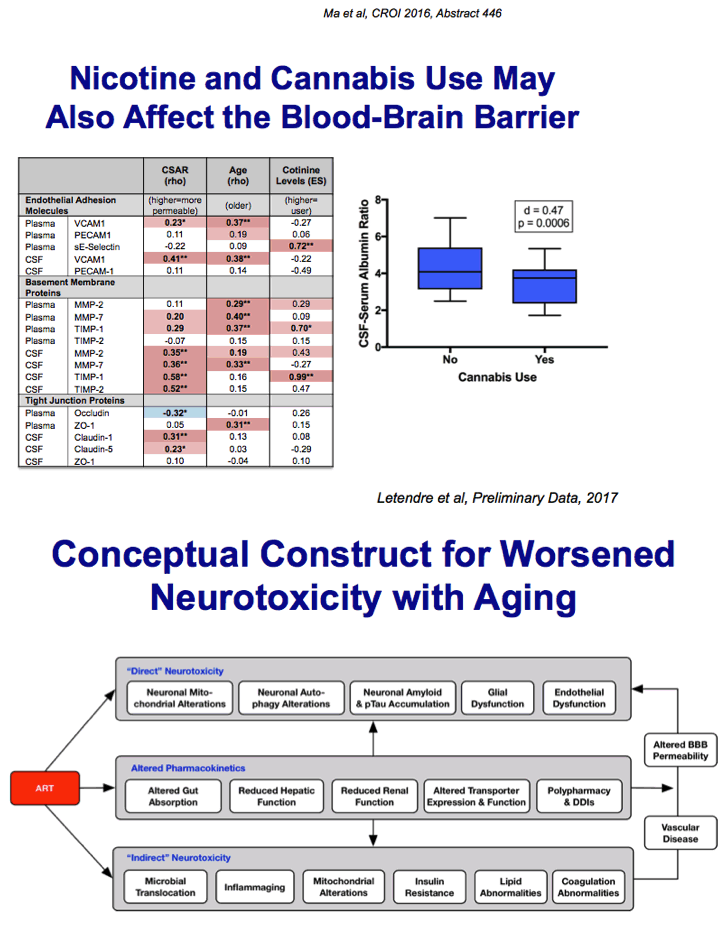
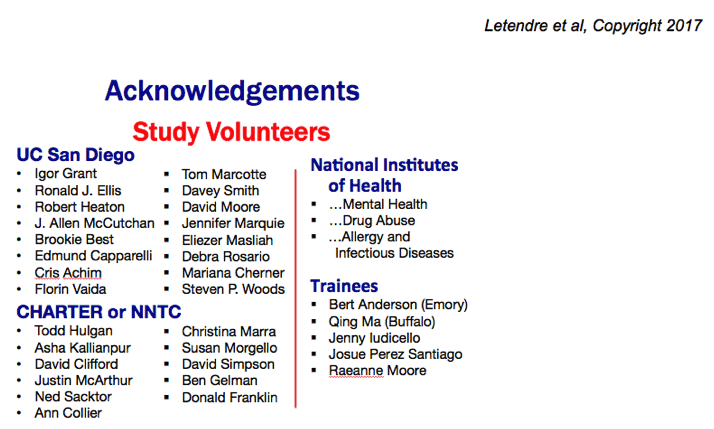
|
| |
|
 |
 |
|
|